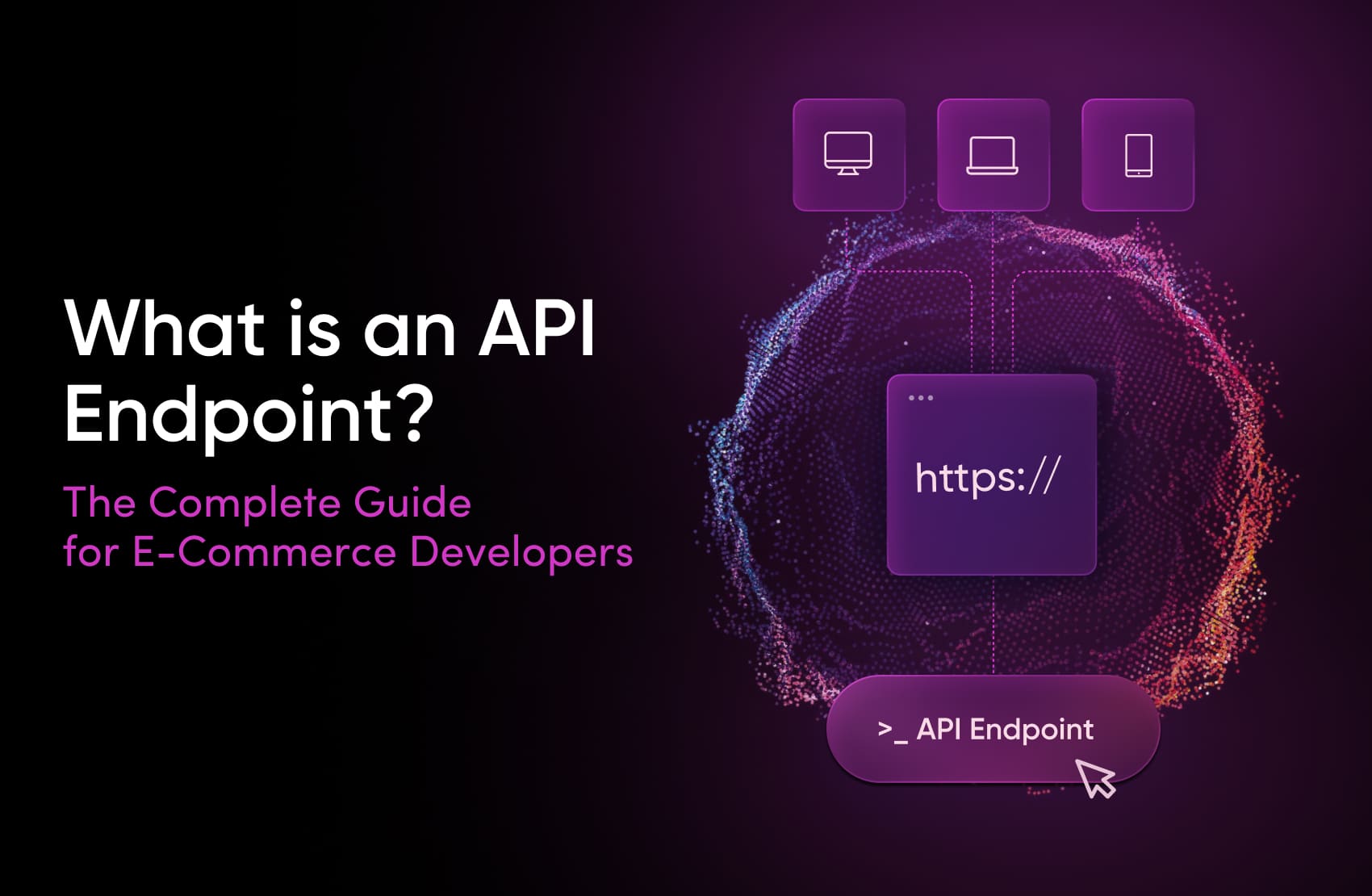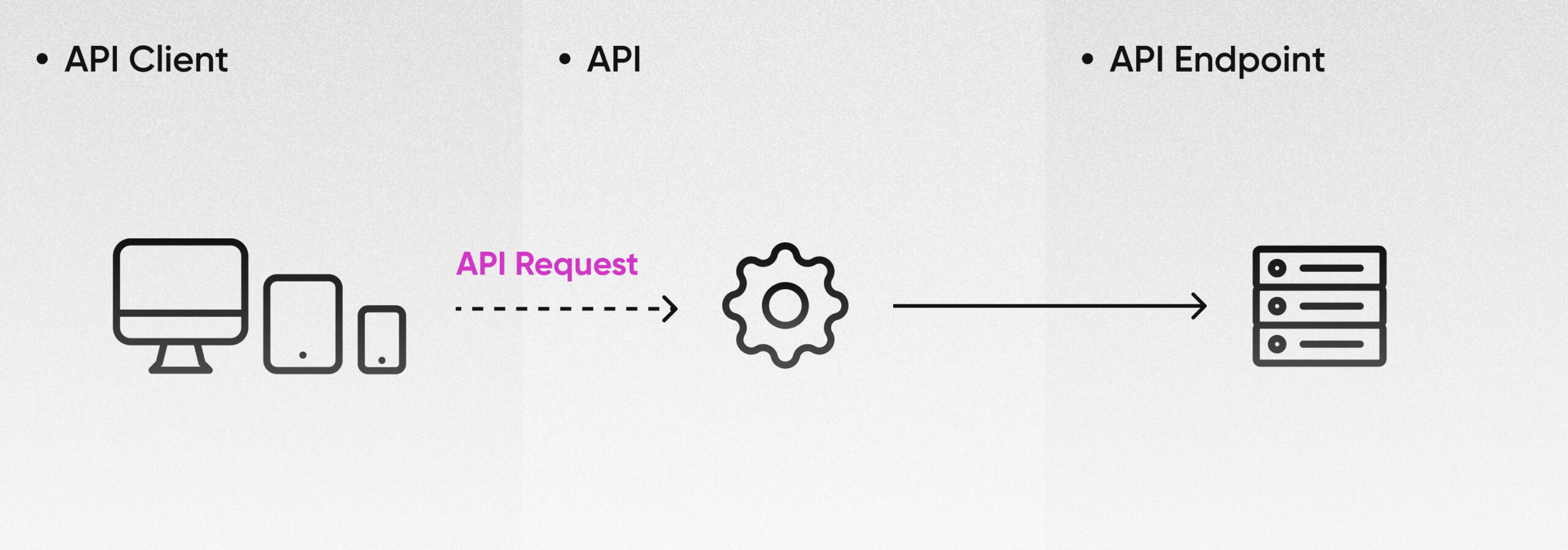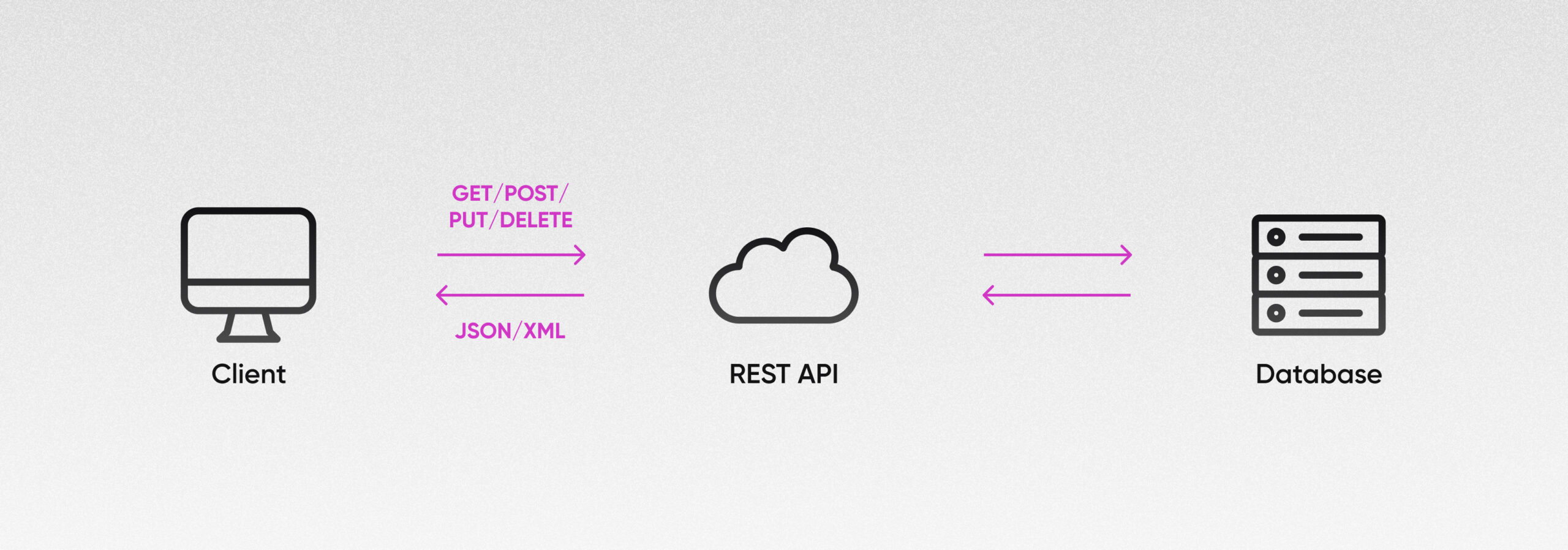What is an API Endpoint? The Complete Guide for E-Commerce Developers

An API endpoint is a designated URL (Uniform Resource Locator) or URI (Uniform Resource Identifier) that serves as an entry point for web-based applications, allowing communication between clients and services.
API endpoints are associated with specific functions or resources and accept HTTP requests like GET, POST, PUT, or DELETE to perform actions or retrieve data.
fabric offers a variety of API endpoints tailored to assist retailers, including Cart and Checkout, Experiences, Identity, Loyalty, Offers, Orders, fabric Pay, Products, and Subscriptions endpoints.
These fabric API endpoints enable retailers to manage a full spectrum of e-commerce functions and services effectively.
API endpoints in e-commerce serve as specific URLs or URIs that enable communication and data exchange within an e-commerce system. They are vital components that facilitate various functionalities and interactions in e-commerce development. There has been exponential growth in the number of API endpoints being created and used in recent years. According to the State of the API Economy report by Apigee (Google Cloud’s API management platform) in 2020:
“The number of publicly available APIs has been increasing rapidly. In 2010, there were approximately 5,000 public APIs, and by 2020, that number had grown to over 22,000 public APIs.”
This statistic highlights the significant role that APIs and their endpoints play in modern software development, as businesses and developers continue to leverage APIs to enable new functionalities, integrate services, and expand their digital offerings.
[toc-embed headline=”What is an API Endpoint?”]
What is an API Endpoint?
API endpoints are essential components in web-based applications and services, as they define how external software components can communicate with and utilize the features provided by the API.
Let’s illustrate how API endpoints work with a simple example involving a hypothetical e-commerce website’s API for retrieving product information.
How API endpoints work
In this example, we’ll focus on the “GET /products” API endpoint, which allows clients to retrieve a list of available products.
Step 1: Identification and Selection
Imagine a developer working on a mobile app for this e-commerce website. The developer wants to display a list of products available for purchase within the app.
Step 2: Endpoint Identification
The developer identifies that the “GET /products” API endpoint is the one they need to access to retrieve the product data.
Step 3: HTTP Request
The mobile app sends an HTTP request to the API endpoint using the GET method.
The request might look something like this:
GET /products HTTP/1.1
Host: api.example.com
Step 4: Server Processing
The server may have a database or some data source that stores information about the products available for sale.
Step 5: Business Logic
Once the API server receives a request at a specific endpoint, it needs to execute the appropriate business logic associated with that endpoint.
Step 6: Data Retrieval
After the business logic is executed, there’s often a need to retrieve or update data from a data source (e.g., a database) to complete the request.
Step 7: HTTP Response
The API server generates an HTTP response and sends it back to the mobile app.
The response includes a JSON-formatted body containing the list of products and an HTTP status code indicating a successful operation (e.g., HTTP 200 OK).
HTTP/1.1 200 OK
Content-Type: application/json
[
{
"id":1,
"name":"Smartphone",
"price":599.99,
"category":"Electronics"
},
{
"id":2,
"name":"Laptop",
"price":999.99,
"category":"Electronics"
},
{
"id":3,
"name":"T-shirt",
"price":19.99,
"category":"Apparel"
},
// ... (more products)
]
Importance of endpoints in e-commerce development
Endpoints play a crucial role in e-commerce development by enabling communication between various components and services of an e-commerce system. Their importance lies in facilitating the smooth operation, scalability, and flexibility of an e-commerce platform.
Differences between APIs and endpoints
| API (Application Programming Interface) | Endpoint |
| Definition: An API is a set of rules and protocols that allows one software application to interact with and use the services and functionalities of another application, service, or system. | Definition: An endpoint is a specific URL or URI that represents a single function or resource within an API. It is a unique address where clients (such as other software applications or devices) can make HTTP requests to access a particular part of an API’s functionality or data. |
| Functionality: APIs define the methods and data formats that applications can use to request and exchange information. They provide a high-level interface for developers to access specific features or data from a software component. | Functionality: Endpoints are more granular and specific. Each endpoint corresponds to a single operation or task that the API can perform, such as retrieving a list of products, updating a user’s profile, or processing a payment. |
| Scope: APIs are broader in scope and encompass the entire set of functions and capabilities offered by a software component or service. They define how various components can communicate and interact with each other. | Scope: Endpoints are part of an API and define how to access a specific feature or data within that API. An API can have multiple endpoints, each responsible for a different operation. |
| Example: A payment gateway API allows an e-commerce application to process payments, offering functions like making payments, refunding orders, or checking transaction statuses. | Example: In an e-commerce API, specific endpoints could include ‘/products’ for retrieving product listings,’ /cart’ for managing a shopping cart, and ‘/orders’ for handling order-related actions. |
[toc-embed headline=”Understanding API Endpoints in RESTful APIs”]
Understanding API Endpoints in RESTful APIs
RESTful APIs (Representational State Transfer APIs) are a type of web API that adhere to the principles of REST architecture. REST is an architectural style for designing networked applications, and RESTful APIs are commonly used in web development due to their simplicity, scalability, and ease of use.
Structure of RESTful APIs
RESTful APIs provide a structured and standardized way for clients and servers to communicate over the web using HTTP methods and resources. Their principles of simplicity, statelessness, and uniformity make them a popular choice for building web services and APIs.
In terms of structure, a RESTful API typically consists of the following elements:
- Resources: The core entities or objects that the API deals with, each identified by a unique URL.
- HTTP Methods: The actions that can be performed on resources (GET, POST, PUT, DELETE, etc.).
- Endpoints: URLs that map to specific resources and actions.
- Request: Includes the HTTP method, headers, and any data needed for the operation (e.g., request body for POST and PUT).
- Response: Contains the HTTP status code, headers, and the representation of the resource (e.g., JSON or XML).
API endpoints are a critical part of the request-response communication in web services and APIs. They define the location, action, and resource involved in a request, enabling clients and servers to interact effectively and consistently. Well-designed and documented API endpoints are essential for building robust and maintainable APIs that serve the needs of both clients and developers.
[toc-embed headline=”Examples of API Endpoints and Their URLs for E-Commerce”]
Examples of API Endpoints and Their URLs for E-Commerce
Cart endpoint
The cart endpoint allows users to manage their shopping cart in an e-commerce application by adding, updating, removing, or viewing items.
- Endpoint: https://prod.cart.fabric.inc/v2/carts
- HTTP Method: GET
- Purpose: This GET request is used to retrieve a list of all carts from the server.
Checkout endpoint
The checkout endpoint allows users to manage their shopping cart in an e-commerce application by completing the checkout process.
- Endpoint: https://prod.checkout.fabric.inc/v2/checkout
- HTTP Method: POST
- Purpose: This POST request is used to checkout a cart.
Products endpoint
The products endpoint is consolidated source for all salable item and vendor information.
- Endpoint: https://live.copilot.fabric.inc/api-product/v1/product/search
- HTTP Method: GET
- Purpose: This GET request is used to get all products in a paginated response from the server.
Orders endpoint
The orders endpoint allows users to manage their ordering, inventory, and warehouse information.
- Endpoint: https://prod01.oms.fabric.inc/api/v2/order/
- HTTP Method: GET
- Purpose: This GET request is used to get orders using orderId in query parameters from the server.
[toc-embed headline=”How to Test API Endpoints”]
How to Test API Endpoints
Testing API endpoints is a crucial part of API development and integration to ensure that they work as expected. Here are step-by-step instructions on how to test API endpoints:
- 1. Understand the API documentation: Thoroughly review the provided API documentation to familiarize yourself with the available endpoints, their functionalities, required parameters, and expected responses.
- 2. Choose an API testing tool: Select an appropriate API testing tool such as Postman, Insomnia, curl or Swagger UI to facilitate efficient and organized testing of the API endpoints.
- 3. Set up your environment: Configure the testing environment, including the API endpoint URLs, authentication credentials, headers, and any necessary configurations to prepare for testing.
- 4. Create API requests: Construct API requests with the required parameters, headers, and request methods (GET, POST, PUT, DELETE) based on the defined functionalities and actions for each endpoint.
- 5. Send API requests: Use the chosen API testing tool to send the created API requests and observe the responses to validate the functionality and behavior of the endpoints.
- 6. Inspect API responses: Carefully analyze the responses received from the API to ensure they align with the expected response formats and contain accurate data.
- 7. Check response data: Validate the response data against the expected values, verifying that the API is providing the correct information for the given requests.
- 8. Test different scenarios: Test the endpoints under various scenarios, including edge cases, erroneous inputs, and different combinations of parameters, to assess the API’s robustness and reliability.
- 9. Document test results: Document the results of each API test, noting any successes, failures, or unexpected behaviors, and make a record of the testing outcomes for future reference and improvement.
By following these steps, you can effectively test API endpoints, ensuring that they meet your requirements and function correctly within your application or integration.

Testing an API endpoint for subscriptions with a GET request.
[toc-embed headline=”fabric Commerce Platform and API Endpoints”]
fabric Commerce Platform and API Endpoints
fabric Commerce Platform (fCP) is a configurable and composable headless commerce solution. It empowers brands with the ability to rapidly deploy and scale unique brand experiences using a versatile management platform and powerful e-commerce APIs. fabric has different API endpoints which can help retailers build superior shopping experiences, some of which include:
- Cart and Checkout endpoints: Online cart and checkout management enabling adding, merging and removing items from the cart, and completing the checkout process
- Identity endpoints: User role management and access privileges to the fabric platform
- Loyalty endpoints: Loyalty management configuration and implementation
- Offers endpoints: Pricing engine to manage promotions and coupons
- Orders endpoints: Centralized ordering, inventory, and warehouse information
- Products endpoints: Consolidated source for all salable item and vendor information
- Subscriptions endpoints: Sell and ship items to customers on a recurring basis
Here’s how fCP functionalities can be exposed through API endpoints in a structured and controlled manner:
- Define the API Endpoints: Clearly outline the specific endpoints that will expose fCP functionalities, aligning them with intended actions or data retrieval operations.
- Structured data format: Utilize a consistent and well-defined data format, such as JSON or XML, to ensure uniformity and ease of consumption for the exposed data through the API.
- Authentication and authorization: Implement secure authentication mechanisms and role-based authorization to control access to the fCP functionalities based on user roles and permissions.
- Rate limiting and throttling: Set limitations on the number and frequency of API requests to prevent abuse and maintain optimal performance by implementing rate limiting and throttling mechanisms.
- Error handling: Develop a robust error handling strategy to provide informative and meaningful error responses, aiding developers in identifying and addressing issues effectively.
- Documentation: Create comprehensive and user-friendly documentation that details each API endpoint, its purpose, required parameters, response structure, and any additional information necessary for integration and usage.
- Versioning: Incorporate versioning into the API design to ensure backward and forward compatibility, allowing for seamless transitions and updates without disrupting existing functionality.
- Monitoring and analytics: Implement monitoring tools and analytics to track API usage, performance, and other key metrics, enabling proactive identification of issues and optimization of the API.
- Security measures: Enforce stringent security measures, including encryption, access controls, and data validation, to safeguard sensitive data and maintain the overall security of the fCP functionalities.
- Testing environment: Create a dedicated testing environment to simulate various scenarios and thoroughly test the API endpoints, ensuring reliability, functionality, and adherence to requirements before deployment.
In conclusion, exposing fCP’s functionalities through well-structured and controlled API endpoints involves careful planning, security measures, documentation, and monitoring. To learn more about how to use these endpoints effectively, please visit fabric’s Developer Portal.
[toc-embed headline=”API Endpoint FAQ”]
API Endpoint FAQ
What is an API endpoint example?
The cart endpoint allows users to manage their shopping cart in an e-commerce application by adding, updating, removing, or viewing items. Below is an example of a fabric cart endpoint:
- Endpoint: https://prod.cart.fabric.inc/v2/carts
- HTTP Method: GET
- Purpose: This GET request is used to retrieve a list of all carts from the server.
How do API endpoints differ from APIs?
An API is a broader concept that encompasses the entire interface and set of rules for interacting with a software component or service. API endpoints, on the other hand, are specific URLs or URIs that represent individual operations or resources within that API. You can think of API endpoints as the individual “routes” or “endpoints” that you access to perform specific actions or retrieve specific data from the API.
What is the significance of RESTful API endpoints in web development?
RESTful API endpoints provide a well-defined and standardized way to interact with web services, making them an essential part of modern web development. They promote simplicity, scalability, and interoperability, making it easier for developers to create, maintain, and consume web APIs.
How do I identify and define API endpoints for my application?
Identifying and defining API endpoints for your application is a crucial step in designing a web API. To do this effectively, follow these steps:
- Understand your application’s functionality: Gain a comprehensive understanding of what your application does and what functionalities it offers.
- List resources: Identify and make a comprehensive list of the resources that your application will expose through the API.
- Determine CRUD operations: Define the CRUD (Create, Read, Update, Delete) operations that can be performed on each resource.
- Define resource URLs: Assign clear and logical URLs to each resource to represent their endpoints.
- Specify request and response formats: Clearly define the expected request and response formats for each endpoint to maintain consistency and clarity.
- Authentication and authorization: Decide on the authentication and authorization mechanisms needed to secure access to the endpoints.
- Versioning: Plan for versioning to handle future updates and changes to the API without breaking existing implementations.
- Documentation: Document the endpoints, their functionalities, required parameters, and expected responses for developers to easily understand and use the API.
- Testing: Thoroughly test each endpoint to ensure they function as expected and handle various scenarios appropriately.
- Peer Review: Conduct peer reviews to get feedback on the defined endpoints and make improvements or corrections based on the feedback.
- Iterate and refine: Continuously iterate and refine the defined endpoints based on feedback, testing, and changing application requirements.
What are some best practices for securing API endpoints from potential vulnerabilities?
Securing API endpoints is crucial to protect sensitive data, maintain the integrity of your application, and prevent unauthorized access or malicious attacks. Here are some best practices for securing API endpoints from potential vulnerabilities:
- Authentication: Authenticate users and ensure they are who they claim to be before granting access to the API.
- Authorization: Control and define permissions for users or systems to access specific API endpoints and functionalities.
- HTTPS: Encrypt data transmitted between the client and server to enhance security and prevent eavesdropping.
- Input validation: Validate and sanitize input data to mitigate potential injection attacks and other security vulnerabilities.
- Rate limiting: Restrict the number of API requests a client can make within a specific timeframe to prevent abuse and overload on the server.
- Authentication tokens and session management: Use tokens and manage sessions securely to authenticate and maintain user identity during interactions with the API.
- Cross-origin resource sharing (CORS): Implement policies to control cross-origin requests and prevent unauthorized access from different domains.
- Error handling: Develop a robust error handling mechanism to provide informative and secure responses in case of failures or exceptions.
- Security headers: Set appropriate security headers to enhance protection against various types of attacks like XSS, clickjacking, etc.
- API versioning: Version your APIs to ensure backward and forward compatibility while introducing changes or updates to the API structure or behavior.
- API gateway: Utilize an API gateway as a centralized entry point to manage, monitor, and secure API traffic efficiently.

Software Engineer @ fabric. Former Software Engineer @ Kiwi Creations & Microperts.

